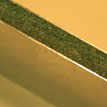
Bonding is achieved by pressing clean activated surfaces together after applying a bonding agent (the "glue"). The agent cures using either oxygen (normal paper glue), water (e.g. polyurethane glue) or a chemical reaction in a two component bonding agent (e.g. epoxy).
Joints made with adhesive bonding are characterized by good strength (when done corectly), by the facts that no or only little heat is introduced to the parts and that many different materials can be joined.
Danish Name
Category
Materials
Typical products
Pedestrian bridge
Airplane floor
ReferencesColoplast
Environmen- tal notes
Keywords
Assembly
Photo
Copyright
This page is part of Design inSite
Disclaimer